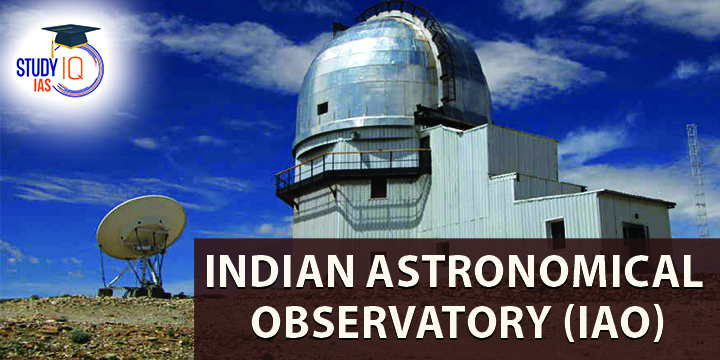Table of Contents
About the Indian Astronomical Observatory (IAO)
- Location:
- Indian Astronomical Observatory is located in Hanle village near Leh in Ladakh.
- Indian Astronomical Observatoryis situated at an altitude of 4500 meters atop Mt. Saraswati in the vast Nilamkhul Plain in the Hanle Valley of Changthang.
- The site is a dry, cold desert with sparse human population and the ancient Hanle monastery is its nearest neighbour.
- Key highlights of Indian Astronomical Observatory, Hanle:
- Hanle is one of the world’s highest located sites for optical, infrared and gamma-ray telescopes.
- It is currently the ninth highest optical telescope in the world.
- It was established in 2001 and is operated by the Indian Institute of Astrophysics, Bangalore.
- Major Telescopes at Indian Astronomical Observatory, Hanle site:
- Himalayan Chandra Telescope (HCT): It is an optical-infrared telescope named after India-born Nobel laureate Subramanian Chandrasekhar. This telescope is remotely operated from CREST, Bangalore using dedicated satellite links.
- GROWTH-India Telescope: It is the country’s first fully robotic research telescope.
- High Altitude Gamma Ray Telescope (HAGAR): It is an atmospheric Cerenkov experiment with 7 telescopes setup in 2008.
Indian Astronomical Observatory: Major Highlights of the Study
- Objective: To find ideal locations around the world to build next big telescope based on local meteorological data collected over many years.
- Plan of action: As part of the study, researchers have carried out a detailed analysis of the night time cloud cover fraction over 8 high altitude observatories:
- Indian Astronomical Observatory (IAO) in Hanle, Merak (Ladakh) and Devasthal (Nainital) in India,
- Ali Observatory in the Tibet Autonomous Region in China
- South African Large Telescope in South Africa
- University of Tokyo Atacama Observatory
- Paranal in Chile
- National Astronomical Observatory in Mexico.
- Findings of the study:
- The Paranal, located in a high-altitude Atacama Desert in Chile, is the best site in terms of clear skies with around 87% of clear nights in a year.
- The Hanle site, which is much drier than Devasthal and has around 270 clear nights in a year, is one of the emerging sites for infrared and sub-mm optical astronomy (This is because water vapour absorbs electromagnetic signals and reduces their strength).
- IAO-Hanle, and Ali observatories, which are located around 80 km from each other, are similar to each other in terms of clear night skies.
- Devasthal has a slightly larger number of clear nights compared to the other sites in the sub-continent but are affected by monsoons for about three months in a year.
- However, night observations at Indian Astronomical Observatory-Hanle from 2m-Himalayan Chandra Telescope (HCT) are possible throughout the year without any interruption due to monsoons.
Indian Astronomical Observatory: Dark Sky Reserve
- Recently, in September 2022, the Department of Science & Technology (DST) has announced the setting up of India’s first Dark Sky Reserve in Hanle, Ladakh.
- A Dark Sky Reserve is a designation given to a place that has policies in place to ensure that a tract of land or region has minimal artificial light interference.
- The International Dark Sky Association is a U.S.-based non-profit organization that designates places as International Dark Sky Places, Parks, Sanctuaries and Reserves, depending on the criteria they meet.


 UPPSC Previous Year Question Papers, Dow...
UPPSC Previous Year Question Papers, Dow...
 Most Commonly Used Cancer Drugs and Thei...
Most Commonly Used Cancer Drugs and Thei...
 Tansen Biography, Musical Legacy and Mas...
Tansen Biography, Musical Legacy and Mas...





















